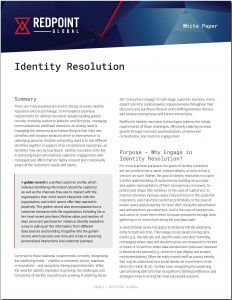 A rushed greeting when you pass an acquaintance on the street is one of life’s common interactions we can all relate to – even if many are now on hold as we practice social distancing.
A rushed greeting when you pass an acquaintance on the street is one of life’s common interactions we can all relate to – even if many are now on hold as we practice social distancing.
We recognize the difference in how it makes us feel versus stopping to have an actual conversation, when you chat about each other’s kids, a new job, or vacation plans. One is a fleeting, all-too brief interlude that is usually quickly forgotten. The other establishes a far deeper, meaningful connection.
The difference between the fleeting interaction and the engaging conversation is analogous to surface level identity management versus the Redpoint approach to identity resolution that underpins the delivery of a superior, hyper-personalized customer experience layered with context and meaning that brings the interaction to life.
Advanced identity resolution and deriving customer context is the Redpoint competitive differentiator.
Walking in Step with the Customer
The key to delivering unprecedented context to a customer relationship is a single customer view, or golden record, that lets a brand know everything there is to know about a customer. A persistently updated golden record includes data of every type and from every source. Built upon singular identity resolution capabilities, it combines every customer identifier – addresses, emails, devices, social, phone numbers – with complete behavioral and transactional data to deliver the context that gives the single customer view its value.
Context goes beyond understanding each discrete interaction in a customer’s journey. It is created by an analytically derived understanding of the relationship between the various interactions and decision points, which in turn creates testable predictions about future interactions and customer decisions. Thus, a contextual customer relationship is the key to optimizing each engagement in the context of the entire customer lifecycle, guaranteeing that a brand is always – always – in sync with the customer.
Simple Identity Management Misses the Mark
Surface level identity management, by contrast, could be using a cookie match or a device identification as the basis to provide a customer a specific offer or content. The difference is that this approach relies on matching at just one moment in time – the fleeting interaction. It might inform a brand that a user of a device likes golf (an assumption made because the device was used to purchase golf equipment), and the brand will serve up golf content. This is not true identity resolution, however, because it fails to take into account that consumers have different identities in different channels, or identities in digital and physical locations, they have households, and they have names that can be spelled and matched in a variety of ways.
Neglecting variables results in a limited, narrow, and incomplete view. A brand that uses this view to serve up content or offers has an extremely high likelihood of introducing friction into the customer experience. It would be like greeting a person on the street and asking about a non-existent partner. A simple match also ignores the trove of behavioral and transactional data, resulting in missed opportunities: perhaps the brand offers a discount on a golf bag that the consumer just bought on another channel; or it serves up an ad for a destination golf vacation even though the customer posted a scathing Yelp review on the same resort.
An incomplete view of the customer, which can be caused by over-matching or under-matching records and/or not having all transactional and behavioral data, handcuffs marketers who must offer relevance with every engagement. Mis-matching identifiers disconnects behavioral, transactional, and demographic data associated with that identifier. The result: diminished relevance, increased customer friction, and lost opportunity.
Identity Resolution Drives Profitable Growth
Delivering a personalized and meaningful customer experience is important for the simple reason that it is what today’s always-on, continuously connected customer expects.
Consider the 2019 BRP Unified Commerce Study, where 87 percent of consumers surveyed said that it is important to receive “a personalized and consistent experience across channels.” A 2019 Harris Poll survey commissioned by Redpoint drives the point home, with 63 percent of consumers surveyed claiming they expect personalization as a standard service, and 37 percent claiming they will flat-out not do business with a company that fails to personalize customer experiences.
Pleasing a customer is a tremendous benefit in and of itself, but even more so as a means to an end. Ultimately, superior customer experiences drive revenue. According to Gartner research, “persona-centric” brands may see a revenue lift of 6 to 10 percent by using transactional, preference, and historical data to form a personalized engagement strategy. Yet brands that use transactional, preference, and historical data while also looking at behavior across devices, analyzing device usage, IoT and sentiment analysis, and first-party, second-party, and third-party data across an anonymous to known record – those brands are considered “customer-centric” and produce a conversion lift of 20 percent or greater.
Providing a customer with a perfectly timed offer based on the entirety of interactions across the customer lifecycle is how a brand engages a customer with a meaningful, lasting impression. This rich, contextual relationship lets a customer know that their value to a brand is defined less by what or how much they buy – or don’t buy – and more by a furtherance and deepening of the relationship. A customer’s lifetime value, in other words, is more important – and ultimately more profitable – than a transactional relationship.
The most complete and continually updated in real-time identity resolution is essential to creating the context that is necessary for exemplary customer experience delivery, and no one understands or delivers this context better than Redpoint.
RELATED CONTENT
Clear the Hurdles for a Personalized Customer Experience
Customer Journeys are Dynamic, Your Engagement Technology Should Be as Well
A Personalized Customer Experience Delivers Loyalty
Be in-the-know with all the latest customer engagement, data management, and Redpoint Global news by following us on LinkedIn, Twitter, and Facebook.

